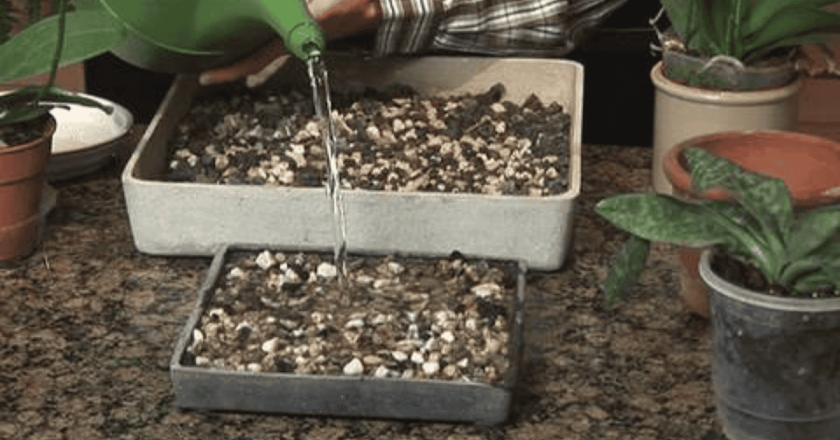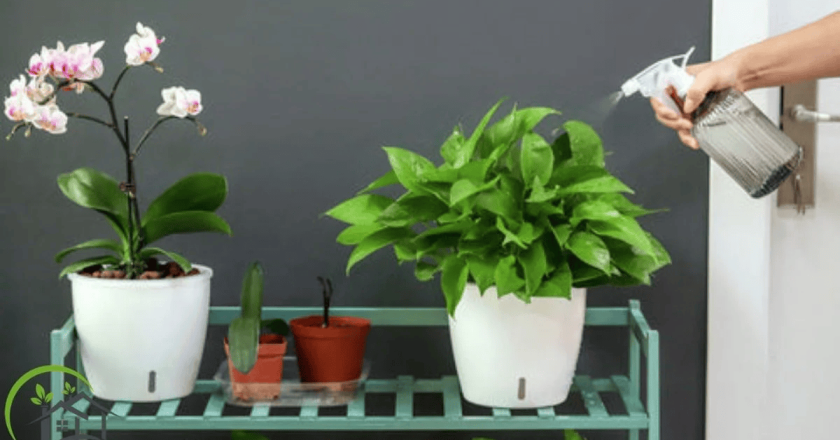When the world outside feels asleep—trees bare, soil frozen, skies gray—it can feel like color and life have packed up and left until spring. But that doesn’t have to be true inside your home.
Indoor blooming plants are a kind of quiet rebellion against winter. While most gardens take a break, these beauties burst with flowers right in your living room, kitchen, or even bathroom. They’re more than decoration. They lift moods, purify the air, and remind you that growth doesn’t stop—no matter the season.
Whether you’re new to indoor gardening or a lifelong plant lover, this list of 23 blooming houseplants will give you options for every room, lighting condition, and lifestyle—including notes on which ones are safe for pets.
Let’s dive in.
🌼 Chrysanthemums
Scientific Name: Chrysanthemum morifolium
Best For: Bright windowsills, seasonal flair

Chrysanthemums (or mums) aren’t just for fall porches. When grown indoors, these vibrant bloomers light up a room with purples, yellows, oranges, and reds. While it’s a bit tricky to get them to rebloom indoors, their initial show is well worth it.
-
Light: Bright, indirect
-
Water: Keep evenly moist
-
Pet Friendly? ❌ No
🌺 Lipstick Plant (Aeschynanthus radicans)

Named for the bright, tubular red flowers that peek out of deep green vines like lipstick from a case, this tropical trailing plant can bloom multiple times a year if kept happy.
-
Light: Bright, filtered light
-
Water: Allow soil to dry slightly between waterings
-
Pet Friendly? ✅ Yes
🌼 Jasmine

The fragrant, star-like white blooms of jasmine bring a breath of summer to winter rooms. Different varieties bloom at other times of the year, so choose one that suits your light levels.
-
Light: Bright, direct,t or filtered
-
Water: Keep the soil evenly moist
-
Pet Friendly? ✅ Yes
🌸 Gloxinia

Gloxinias are all drama. Huge, bell-shaped blooms in velvet red, pink, or purple make them feel like living bouquets. Their soft, fuzzy leaves add even more texture to indoor spaces.
-
Light: Bright, indirect
-
Water: Bottom water to avoid leaf spots
-
Pet Friendly? ✅ Yes
🌷 Regal Geranium (Pelargonium grandiflorum)

These aren’t your grandma’s geraniums (though she might love them, too). Regal varieties have deeply colored, often ruffled petals that pop against lush green leaves.
-
Light: Bright, indirect
-
Water: Let top inch of soil dry out
-
Pet Friendly? ❌ No
🌼 Ixora

Clusters of small, vibrant flowers make Ixora a visual standout. It performs especially well in warm, steamy environments, such as bathrooms.
-
Light: Full sun to bright indirect
-
Water: Keep soil lightly moist
-
Pet Friendly? ❌ No
🌺 Crown of Thorns (Euphorbia milii)

Despite its prickly name, this plant rewards with long-lasting, colorful blooms. It thrives on neglect, making it ideal for those who tend to forget to water.
-
Light: Direct sunlight
-
Water: Let soil dry completely between waterings
-
Pet Friendly? ❌ No
🌸 Hoya Albo Carnosa

Hoyas are tough yet elegant. Albo Carnosa is prized for its variegated leaves, sometimes tinged pink, and waxy, star-shaped flowers that smell subtly sweet at night.
-
Light: Bright, indirect
-
Water: Water sparingly
-
Pet Friendly? ✅ Yes
🌺 Pink Anthurium

These aren’t traditional blooms, but modified leaves (spathes) that stand tall for months. With minimal care, Anthuriums give your home a tropical, almost luxurious feel.
-
Light: Filtered, bright
-
Water: Let soil partially dry out
-
Pet Friendly? ❌ No
🌼 Desert Rose (Adenium obesum)

The bonsai of the blooming plant world. With its sculptural trunk and vibrant flowers, desert rose is stunning and surprisingly easy if you give it what it wants: sun and drought.
-
Light: 6+ hours of sun
-
Water: Every 2–3 weeks
-
Pet Friendly? ❌ No
🌸 Moth Orchid (Phalaenopsis)

Elegant, graceful, and far easier than they look. A healthy moth orchid can bloom for 3 months straight, and with minimal fuss.
-
Light: Bright, indirect
-
Water: Once per week, let drain fully
-
Pet Friendly? ✅ Yes
🌼 Bromeliad

Fun fact: this pineapple relative has just one flower spike, but it lasts months. Its quirky leaves and colors bring the tropics indoors—even when there’s snow outside.
-
Light: Bright, indirect
-
Water: Fill the center cup, water the soil occasionally
-
Pet Friendly? ✅ Yes
🌸 Purple Oxalis

Shamrock-shaped purple leaves fold at night and reopen during the day. White or pink flowers bloom regularly, but the foliage is the real standout.
-
Light: Bright, indirect
-
Water: Keep slightly moist, allow dormancy
-
Pet Friendly? ❌ No
🌺 Cyclamen

Butterfly-like flowers hover above patterned leaves, especially through late winter. They need cool temps—don’t overheat them.
-
Light: Bright, indirect
-
Water: Bottom watering preferred
-
Pet Friendly? ❌ No
🍊 Calamondin Orange

Yes, this indoor citrus actually produces edible oranges. Its fragrant white blossoms offer a hint of spring all year round.
-
Light: Full sun or grow light
-
Water: Let dry slightly between watering
-
Pet Friendly? ❌ No
🌸 Holiday Cactus (Schlumbergera)

They’ve been passed down for generations for a reason. With care, your Christmas, Thanksgiving, or Easter cactus can bloom for decades. Holiday cacti are cherished for their vibrant blooms during the colder months. For detailed care instructions, refer to Patch Plants’ guide on Christmas Cactus Care Tips.
-
Light: Bright, indirect
-
Water: Let soil dry 75% before watering
-
Pet Friendly? ✅ Yes
🌼 Kalanchoe

Bright flower clusters that last weeks. A perfect low-fuss bloomer for desks and windowsills.
-
Light: Bright sun
-
Water: Let soil dry fully between watering
-
Pet Friendly? ❌ No
🌸 African Violet

They’re a bit fussy, but African violets reward with year-round blooms. Use lukewarm water and avoid wetting the fuzzy leaves.
-
Light: Bright, indirect
-
Water: Keep evenly moist
-
Pet Friendly? ✅ Yes
🌼 Peace Lily (Spathiphyllum)

Classic. Graceful. Reliable. With the right care, peace lilies bloom several times a year, adding elegance and simplicity to any space. Peace lilies are known for their elegant white blooms and air-purifying qualities. Learn how to keep your peace lily thriving by visiting Patch Plants’ Peace Lily Care Guide.
-
Light: Moderate to bright, filtered
-
Water: Keep soil slightly moist
-
Pet Friendly? ❌ No
🌸 Flowering Maple (Abutilon)

Paper lantern-like blooms dangle from maple-shaped leaves. Great for bright corners where other plants struggle.
-
Light: Bright, indirect
-
Water: Water when the top inch is dry
-
Pet Friendly? ❌ No
🌺 Amaryllis

A holiday favorite, but versatile year-round. Huge trumpet-shaped flowers burst open like firecrackers. Store bulbs when dormant and bring them back later.
-
Light: Bright, indirect
-
Water: Water when soil dries halfway
-
Pet Friendly? ❌ No
🌼 Clivia

Understated yet elegant, Clivia produces orange or yellow trumpet-shaped flowers. It needs a dry, cool period to bloom again.
-
Light: Moderate to bright
-
Water: Water infrequently during dormancy
-
Pet Friendly? ❌ No
🌸 Rex Begonia

While known for its colorful leaves, rex begonia also sends out occasional small pink or white flowers. Low fuss and incredibly striking foliage.
-
Light: Bright, indirect
-
Water: Keep the soil slightly moist
-
Pet Friendly? ❌ No
🌱 General Plant Care Tips
Caring for indoor blooming plants isn’t always about precision—it’s about rhythm. It’s knowing when to water, when to wait, when to rotate a pot just a few inches toward the light. It’s learning your plant’s signals—slightly drooping leaves, faded blooms, a stubborn refusal to flower—and responding like a gardener who listens.
If you’re not sure where to start, or if you’ve already collected a small jungle of leafy friends and are running into issues (like yellowing leaves, crispy tips, or flower drop), it helps to go back to the basics.
That’s where Patch Plants’ detailed Plant Care Guide really earns its place. It covers all the foundational elements you need for successful indoor gardening:
-
Lighting nuances: Not just “bright” or “dark”—but how to work with what your space gives you, from south-facing window strengths to the gentle glow of indirect light in a bathroom.
-
Watering logic: Understanding how plant types differ (succulents vs. tropicals), and why sticking your finger into the soil is often better than following a rigid schedule.
-
Humidity and airflow: Crucial for flowering species like orchids and anthuriums, and often overlooked. Learn how to create microclimates in your home without investing in fancy equipment.
-
Fertilizing frequency: When your plant needs a boost—and when you should hold back.
Whether you’re troubleshooting or want to get better at noticing the quiet shifts in your plant’s health, this guide is worth bookmarking. You’ll probably come back to it more than once.
🌐 Read the Full Plant Care Guide at Patch Plants →
✨ Final Thoughts
Bringing blooming plants into your home during winter isn’t just about beauty—it’s about feeling grounded, hopeful, and connected to life even when it’s cold and quiet outside.
Whether you fill your home with orchids, citrus trees, or trailing lipstick plants, each flower is a small declaration: growth is still happening. Light still matters. And beauty, even in winter, is always possible.
FAQs
1. What are the easiest indoor blooming plants for beginners?
Some of the easiest flowering houseplants include African violets, holiday cactus, kalanchoe, and moth orchids. These plants are forgiving, require minimal care, and bloom reliably with the right amount of light and a consistent watering routine.
2. How can I encourage my indoor plants to bloom during winter?
Most indoor blooming plants need bright, indirect light, consistent watering (but not overwatering), and sometimes a dormant or rest period. Plants like amaryllis and holiday cactus bloom after experiencing slightly cooler temperatures and reduced light.
3. Are all indoor blooming plants safe for pets?
No. While some plants are pet-safe (such as African violets, jasmine, and lipstick plants), others, like peace lilies, anthuriums, and crown of thorns, are toxic to cats and dogs. Always check each plant’s safety rating before bringing it home.
4. Why is my flowering plant not producing blooms indoors?
This can occur due to insufficient light, over-fertilization, or skipping the rest period that some plants require to trigger blooming. Additionally, using the incorrect type of soil or allowing drafts near the plant can impact its blooming cycle.
5. Can I grow flowering plants in low light?
Only a few flowering plants tolerate low light, and most prefer at least moderate to bright, indirect light. If you have low-light conditions, consider adding a grow light to encourage blooming in plants like begonias or moth orchids.




